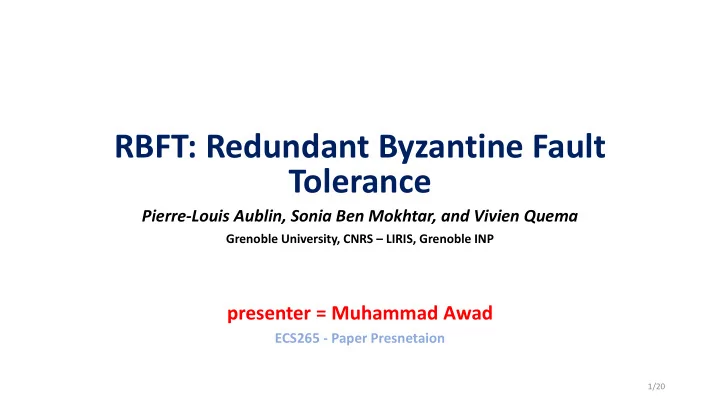

RBFT: Redundant Byzantine Fault Tolerance Pierre-Louis Aublin, Sonia Ben Mokhtar, and Vivien Quema Grenoble University, CNRS – LIRIS, Grenoble INP presenter = Muhammad Awad ECS265 - Paper Presnetaion 1/20
Goal and Motivation: • Robust BFT protocol (achieves good performance when faults occur). • We can detect and recover from a malicious primary, but the primary can be smartly malicious. • What is the throughput of a non-malicious primary? • We can’t tell. 2/20
RBFT: High-level Id Idea • Leverage multicore architectures. • Multiple (f + 1) instances of a BFT protocol are executed in parallel. • Each instance has its own primary replica. 3/20
RBFT: High-level Id Idea • All protocols order requests, but the master instance executes them. • Other instances (backup instances) order requests and compares the highest throughput to the master instance throughput. • If majority (2f + 1) concludes that master is slower, it’s considered malicious and new primaries are elected for each instance. 4/20
RBFT: Detailed Protocol Steps 1. Client sends request to all nodes: << REQUEST , o, rid, c> σc , c> μc • Nodes authenticate the MAC (make sure it was sent by the client). • If valid, validate the signature of the request (if not valid blacklist client). • If already executed send back reply. 5/20
RBFT: Detailed Protocol Steps 2. Propagate request: < PROPAGATE < REQUEST , o, s, c> σc , i> μc • After reciving f + 1 propagate requests, a node give requests to local replicas. 6/20
RBFT: Detailed Protocol Steps 3. Primary replica of each instance sends PRE-PREPARE messages. • Non-primary waits for the PRE-PREPARE message from instance primary. 7/20
RBFT: Detailed Protocol Steps 4. Replicas of each instance receives PRE-PREPARE messages. • Verifies validity of MAC • Wait for the f + 1 instances before sending PREPARE messages (i.e. avoid fake throughput boost). 8/20
RBFT: Detailed Protocol Steps 5. Sending COMMIT messages. • After receiving 2f matching PREPARE from replicas (same protocol instance), consistent with PRE-PREPARE message, a replica sends COMMIT messages 9/20
RBFT: Detailed Protocol Steps 5. Receiving COMMIT messages. • After receiving 2f+1 matching COMMIT messages (same protocol instance), a replica gives the ordered request to its node. 10/20
RBFT: Detailed Protocol Steps 6. Execution and reply. • Each time a node receives request from its replicas (master instance) it executes the operation, then it sends the reply. • Once the client receives f+1 valid and matching replies it accepts the result of the request execution. 11/20
RBFT: Monitoring Mechanism • Detect faulty master protocol instance. • Each nodes keeps a counter for each protocol instance to compute throughput of master instance. • nbreqs i = number of requests ordered by replicas that received 2f+1 commit messages. • If the ratio between throughput of master and average of backups is less than a threshold, node request instance change. • Ensure fairness between clients • Nodes measures latency of each request and average latency for each client (between node’s replicas) and a client’s average requests latency . • If request ordered by master instance and request latency > request_threshold • Or, average client requests latency compared between instances > threshold • -> Request instance change 12/20
RBFT: Protocol In Instance Change Mechanism • Nodes keeps counter of instance change messages (cpi i ). • Once a node detects that it needs instance change it sends an INSTANCE_CHANGE message to all other nodes. • When a node j receives INSTANCE_CHANGE message , • If message cpi i < cpi j it ignores the messages (older instance change message) • Else, it checks if it needs to send the INSTANCE_CHANGE message. If it does, it sends the message to all replicas. • Once a node receives 2f+1 valid and matching INSTANCE_CHANGE message it initiates view change for every protocol and increment its instance change messages counter. 13/20
Results 1. Fault free. 14/20
Results 2. Worst-attack I (faulty f nodes – primary instance correct) • Decrease throughput w/o requiring view change • Client sends verifiable requests to all replicas except master’s primary instance node p . • Faulty nodes sends PROPAGATE messages to p • Faulty replicas of master instance sends invalid messages or don’t take part in the protocol. 15/20
Results 2. Worst-attack I (faulty f nodes – primary instance correct) 16/20
Results 3. Worst-attack II (faulty f nodes – primary instance not correct) • Primary of master instance runs on faulty node • Faulty client is trying to reduce backup throughput. So, • Faulty clients send invalid requests to correct nodes • Faulty nodes send invalid messages to non- faulty ones and don’t participate in propagate phase. • Replicas of the backup instance faulty nodes send invalid messages and don’t take part in the protocol. 17/20
Results 3. Worst-attack II (faulty f nodes – primary instance not correct) 18/20
Results 4. Fairness Instance change 19/20
Conclusion 1. State-of-the-art robust BFT protocols are not robust. 2. RBFT leverages multicore architectures and runs multiple instances of BFT protocols; while monitoring throughput and fairness. 3. During an attack, the throughput degradation due to malicious primary is 3%. 4. Degradation gets lower as f increase. 20/20
Recommend
More recommend